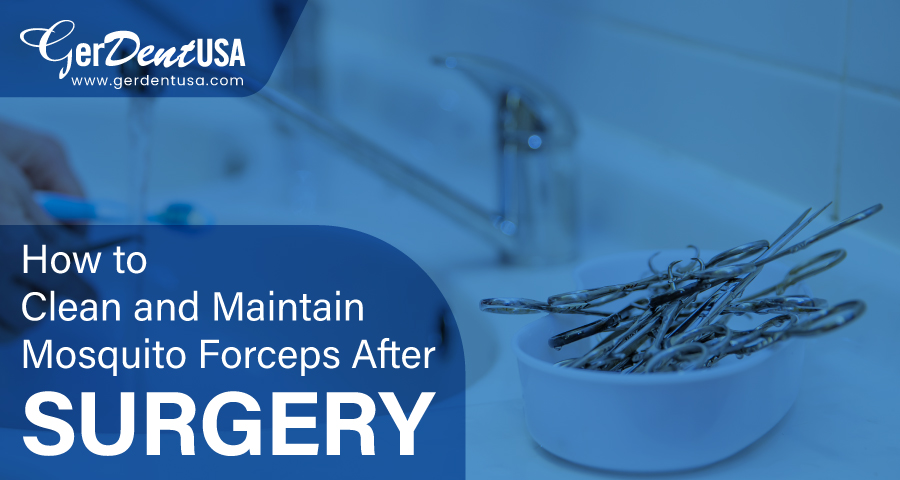forceps are common dentistry instruments. These come in a number of types and variations. Each variant has a specific structure, making it unique for the intended purpose.
Mosquito forcep is one of the most important dental forceps for tissue and blood vessel clamping. Besides, the extraction forceps are crucial for removing the tooth.
Apart from that, there are several different dentistry clamping forceps, such as Baby Mixter forceps, Kocher Hemostatic Forceps, and Crile Forceps. Each of them is special in structure and function.
Here, we will comprehensively compare Mosquito surgery forceps and other common forceps used in dentistry. But first, let’s overview the history and uses of Mosquito Clamping Forceps.
Invention and Purpose Of Mosquito Forceps
Mosquito surgical forceps available today are far different from their earliest version regarding craft and quality.
In the 19th century, William Halstead, a founder of John Hopkins University, a pioneer of the aseptic technique, and a supporter of anesthetics, created these forceps. Medical professionals also call these forceps “Halsted-mosquito.”
Like Hemostatic forceps, the purpose of designing forceps mosquito was to assist surgeons in manipulating tiny blood veins and managing bleeding during surgeries.
Structure-wise, these feature a short length with a curved or straight end and jaws with tiny interlocking ridges.
Moreover, they have a ratchet-lock mechanism that keeps them in place for longer. As a result, Halsted Mosquito minimizes handling fatigue during hectic surgeries.
Uses Of Mosquito Halsted Forceps
Mosquito forceps are versatile nature forceps. These are helpful not only in dentistry but also in other surgical procedures. The sole purpose of these forceps is to prevent blood loss. However, these are helpful in grasping and handling delicate tissues.
Let’s discuss how these dental forceps help surgeons prevent blood loss.
Use in Cauterization
In cauterization, the mosquito forceps help dentists and other surgeons to cut or burn dead tissues and other biological structures. Actually, these forceps clamp the vessel right before the part that is to be discarded.
This way, they prevent blood loss from tiny vessels and other delicate bodily structures.
Use in Ligation
In ligation, Halsted mosquitoes are ideal for clipping off the delicate blood vessels that need to be sutured or ligated. Thus, they minimize the likelihood of procedural complications by preventing blood loss.
Special Use in Dentistry
In dentistry, instead of clamping blood vessels, these Mosquito clamps are ideal for creating a temporary wall, making it convenient for dental surgeons to place the restorative material.
Mosquito Forceps Vs Common Dental Forceps
The Halsted mosquito can be compared with other dentistry forceps regarding two major factors. These include structural features and intended purpose.
As we have discussed in the introduction, there are several forceps helpful for dental practitioners. Each of them has some unique features. Let’s see how Mosquito surgery forceps are different from the rest of the dentistry forceps.
Comparison With Hartman Forceps
Both types of forceps have mosquito designs. Actually, the Hartman mosquito has teeth on the tips in addition to serration along the jaws. On the other hand, the Halsted mosquito has no teeth, only serrated jaws.
Apart from that, regarding use, both kinds of forceps have some differences. Hartman forceps are useful for fine tissue dissection as well as clamping blood vessels. In contrast, Halsted Mosquito forceps are only meant for clamping delicate blood vessels and fine tissues. Dental practitioners do not use these forceps for dissection purposes.
Talking about their common features, both patterns have scissors-like structures. Moreover, Hartman, as well as Halsted forceps, have serrations on their jaws. Besides that, both variations feature finger rings with ratcheted handles for surgeons’ convenience.
Comparison With Baby Mixter Hemostatic Forceps
Baby Mixter Hemostatic Forceps differ from Halsted mosquito in use as well as in structure. The jaws of Baby Mixter forceps are half-serrated, while the mosquito pattern has serrations along the length.
Moreover, Baby Mixter Hemostatic Forceps help dental surgeons clamp, dissect, or grasp tissue. On the contrary, Halsted mosquito clamps are special for gripping delicate blood vessels for ligation and cauterization purposes.
Mosquito Forceps Vs Extraction Forceps
Both patterns of dental forceps are far different from each other. Halsted mosquitoes are intended to prevent blood loss by clamping the ruptured or cut blood vessels. These are delicate in design with serrated jaws and ratchet-handle.
On the other hand, tooth extraction forceps have a robust structure with a plier design handle. Moreover, these have special design for removing the tooth from the socket after its luxation and elevation.
Final Comment!
forceps Mosquito or Halsted mosquito are special forceps helpful in multiple surgeries for preventing blood loss. These have a few similarities with some of the other dental forceps. Yet, they are different because of their unique specialty and structure.
If you want to buy any kind of dental surgical forceps, visit GerDentUSA.com. They have a wide range of German stainless steel dental instruments. Moreover, you can ask them to modify or manufacture special dentistry tools for you.
You may also like
-
Effortless Pigmentation Mark Removal: Exploring the Benefits of Yellow Laser Treatment
-
Pelvic Mesh Implants: What You Should Know About Potential Side Effects
-
How to Recover From a Foot Injury
-
Finding Balance: 7 Stores Offering the Best Traditional Chinese Medicine for Stress Relief
-
Sildisoft 100 and Valentine’s: Crafting Moments of Love

